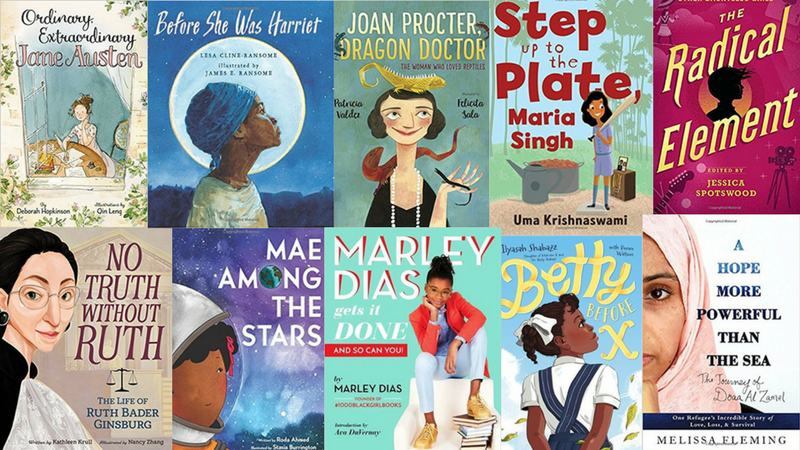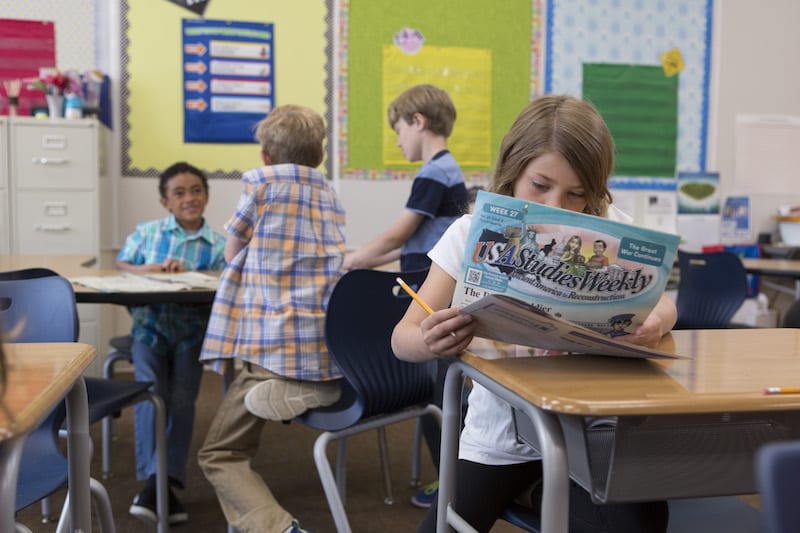Teaching Sixth Grade Social Studies and Language Arts Together
Integrating language arts and social studies can pb to powerful gains for kids. Why?
There are a few key reasons. First, kids oft honey the content covered in social studies—think volcanoes, Egypt, dogs—which tin motivate them to make progress in ELA. Second, the literacy skills that overlap with social studies are also the ones nosotros use most in adult life. Just in your own Internet time today, you probably accept had to read informational text, carry inquiry, and clarify current events.
Finally, intentionally integrating language arts and social studies tin assist to ensure that the latter doesn't become lost with the emphasis on reading and math happening in nigh schools.
Then how can you integrate ELA and social studies? Here are a few smart strategies.
1. Build an awesome library of informational texts.

This might audio like the most obvious proposition, but it's an important one. Inquiry shows that despite the Common Core's push for nonfiction, kids are still reading far more fiction than informational text throughout their schooling. The amount of quality nonfiction has increased, however. You can find swell texts for almost any social studies topic you might cover, from space to biographies to women's history.
2. Have a classroom news anchor.
If you have classroom jobs, this is a nice addition to the lineup. The function of the news anchor is to share one to three events happening in the news during your morning time meeting or another transition time. Students can then talk over what's happening or respond in writing.
iii. Become beyond report writing.
Oftentimes when nosotros ask kids to write in social studies, the focus is on advisory writing or reports. This kind of writing has its identify, but there is also room for creative, reflection, and opinion writing tied to social studies content. We beloved these visual social studies writing prompts.
four. Keep things fresh with classroom magazines.

One of the challenges of traditional social studies textbooks is that they tin can frequently experience stale by midyear. That's where a great nonfiction library tin can come in, but we also like classroom magazines for incorporating fresh social studies content besides. Studies Weekly is a favorite of ours because everything is aligned to the social studies and linguistic communication arts standards for your state.
5. Put students' interview skills to examination.
Conducting interviews or oral histories of relatives or community members is a great style to do speaking, listening, and writing skills. This kind of projection too easily ties into numerous social studies units. Nosotros love this Slideshare for more information on doing oral history projects.
6. Build vocabulary.
The world of social studies comes with its own rich and detailed vocabulary, and students lose basis when they don't accept the context or background cognition for new words. Creating word walls for your social studies units can be a great way to build some of that context and support.
7. Analyze chief sources.
Kids of all ages tin can strengthen their close reading and analysis skills by examining primary sources. Photographs tin be a particularly useful manner to build writing and reflection skills. The Library of Congress offers a number of lesson plans on photographic assay, including this one on the Ceremonious War.
8. Consider historical role play.
Role play can be a great way to synthesize a number of literacy skills, including research, writing, speaking, and listening. Here blogger Fourth Class Flipper explains how she uses role play during her Revolutionary War unit.
nine. Use a class timeline.
A timeline tin be a good strategy to help students synthesize the data they have learned in various social studies units throughout the year. It can also help students put new historical information into context, in both social studies and language arts.
x. Appraise historical thinking rather than facts.
When we emphasize facts in social studies (e.g., "When did the Ceremonious War offset?"), we may lose out on the deeper literacy skills required for more sophisticated historical understanding. The Stanford History Teaching Group offers close to 100 online historical assessments designed to measure understanding over facts.
Source: https://www.weareteachers.com/integrating-language-arts-and-social-studies/